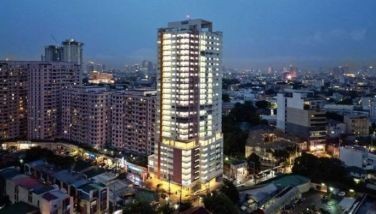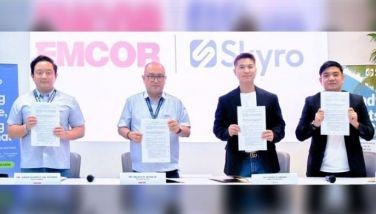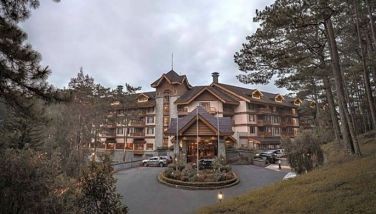Merrill Lynch eyes $500-M fund for Philippine banks
April 16, 2002 | 12:00am
US-based investment giant Merrill Lynch will put up a $500-million facility for Philippine banks in need of capital but are reluctant to allow new investors to come in.
Bangko Sentral ng Pilipinas (BSP) sources revealed that Merrill Lynch has put the funds on stand-by for banks that plan to raise so-called tier-2 capital, which refers to long-term money from sources other than their shareholders.
Also known as mezzanine debt, tier-2 capital allows banks to source capital funds without diluting their shareholders, although investors still have the option to convert their investment into equity after a specified period.
Tier-2 capital is a form of subordinated long-term debt that is paid off only after the depositors and other creditors have been paid in case the bank becomes insolvent.
In contrast, tier-1 capital refers to the core or permanent capital of the bank.
The BSP prefers Tier-2 capital because it could be used like equity for banks with low CAR while providing creditors with some protection against insolvency.
According to sources the Merrill Lynch special facility would solve the dilemma in the Philippine banking industry where most banks were still owned by wealthy Filipino families that have no inclination to allow new investors into their banks.
In their desire to keep management control, sources said that even some of the country’s biggest commercial banks would rather risk having their capital adequacy ratio (CAR) dip below the 10-percent minimum set by the Bank for International Settlements and the eight percent ratio required by the BSP.
The BSP has been encouraging banks to expand their capital base to shield the system from external shocks such as the 1997 financial crisis. With a strong capital base, banks would have rare resources in case a similar crisis develops.
To date, only Metropolitan Trust and Banking Corp. has opted to raise tier-2 capital and this was two years ago when the bad loans it incurred during the 1997 crisis began to erode the financial health of the entire banking system.
Metrobank raised $100 million in tier-2 capital last January, bought in full by the Singapore-based Dunmor Assets Ltd. This tier-2 capital carried a 10-year maturity and had a fixed rate of 9.8 percent for the first five years.
The banking industry had an average CAR of 16 percent at end-2001 but individual banks did not look as good as the industry average.
The Ayala-owned Bank of the Philippine Islands had a CAR of 20 percent but banks such as Metrobank and Equitable PCI, had a CAR of 11.5 percent, just a hair’s breadth away from the minimum requirement.
Equitable, however, is expected to raise P5 billion and $100 million in tier-2 capital. The bank has already sought the approval of the Monetary Board although the plan had been shelved following the resignation of former Equitable president Deogracias Vistan.
On the other hand, the Lucio Tan-owned Allied Bank, plans to raise $50 to $100 million in tier-2 capital in the third quarter from investors in Hong Kong and Singapore.
Bangko Sentral ng Pilipinas (BSP) sources revealed that Merrill Lynch has put the funds on stand-by for banks that plan to raise so-called tier-2 capital, which refers to long-term money from sources other than their shareholders.
Also known as mezzanine debt, tier-2 capital allows banks to source capital funds without diluting their shareholders, although investors still have the option to convert their investment into equity after a specified period.
Tier-2 capital is a form of subordinated long-term debt that is paid off only after the depositors and other creditors have been paid in case the bank becomes insolvent.
In contrast, tier-1 capital refers to the core or permanent capital of the bank.
The BSP prefers Tier-2 capital because it could be used like equity for banks with low CAR while providing creditors with some protection against insolvency.
According to sources the Merrill Lynch special facility would solve the dilemma in the Philippine banking industry where most banks were still owned by wealthy Filipino families that have no inclination to allow new investors into their banks.
In their desire to keep management control, sources said that even some of the country’s biggest commercial banks would rather risk having their capital adequacy ratio (CAR) dip below the 10-percent minimum set by the Bank for International Settlements and the eight percent ratio required by the BSP.
The BSP has been encouraging banks to expand their capital base to shield the system from external shocks such as the 1997 financial crisis. With a strong capital base, banks would have rare resources in case a similar crisis develops.
To date, only Metropolitan Trust and Banking Corp. has opted to raise tier-2 capital and this was two years ago when the bad loans it incurred during the 1997 crisis began to erode the financial health of the entire banking system.
Metrobank raised $100 million in tier-2 capital last January, bought in full by the Singapore-based Dunmor Assets Ltd. This tier-2 capital carried a 10-year maturity and had a fixed rate of 9.8 percent for the first five years.
The banking industry had an average CAR of 16 percent at end-2001 but individual banks did not look as good as the industry average.
The Ayala-owned Bank of the Philippine Islands had a CAR of 20 percent but banks such as Metrobank and Equitable PCI, had a CAR of 11.5 percent, just a hair’s breadth away from the minimum requirement.
Equitable, however, is expected to raise P5 billion and $100 million in tier-2 capital. The bank has already sought the approval of the Monetary Board although the plan had been shelved following the resignation of former Equitable president Deogracias Vistan.
On the other hand, the Lucio Tan-owned Allied Bank, plans to raise $50 to $100 million in tier-2 capital in the third quarter from investors in Hong Kong and Singapore.
BrandSpace Articles
<
>
- Latest
- Trending
Trending
Latest





























